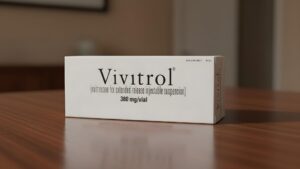Vivitrol is a medication commonly used to help manage alcohol and opioid dependence. Understanding how long it lasts is crucial for patients and healthcare providers to ensure effective treatment and maintain recovery.
In this article, we will explore what it is, how long its effects last, and what influences its duration to help you better understand this treatment option.
What is Vivitrol?
Vivitrol is an extended-release injection of naltrexone designed to reduce cravings and block the effects of opioids and alcohol. Unlike oral naltrexone, which requires daily dosing, it provides a steady release of medication over several weeks. It is primarily prescribed in medication-assisted treatment (MAT) for individuals recovering from opioid addiction or alcohol use disorder to support sustained abstinence.
Vivitrol Treatment works by binding to opioid receptors in the brain, preventing the euphoric and sedative effects of these substances. It is considered safe and non-addictive when administered under medical supervision. Because it does not cause physical dependence, there is no risk of misuse or withdrawal associated with stopping the medication. Common side effects are generally mild, such as soreness at the injection site, and serious reactions are rare when used as directed.
How Vivitrol Works
Typically, the drug’s effects last about four weeks following a single injection. This monthly duration is why injections are generally scheduled every 28 to 30 days. After administration, the extended-release formulation slowly releases naltrexone into the bloodstream, maintaining therapeutic levels that help reduce cravings and block opioids. However, individual response times may vary slightly, and some factors can influence how long the medication effectively works.
After injection into the muscle, naltrexone is absorbed gradually into the bloodstream. Its absorption phase can take several days to reach peak concentration, ensuring a stable release of medication over the month. The drug is metabolized mainly by the liver and excreted through the kidneys. Naltrexone’s steady blood concentration is what sustains its effect during the month, with levels declining towards the end of the cycle, which cues the timing for the next dose.
What Affects How Long Vivitrol Lasts?
Individual differences such as age, body weight, and liver function may alter how the medication is metabolized and cleared from the body. Patients with faster metabolism might experience a shorter duration of effect. Other medications or substances can also affect the drug during its use, potentially impacting how long it remains active.
As the drug’s effects begin to wane near the end of its dosing period, individuals may notice a return of cravings or changes in mood. These signs can indicate that the medication’s blood levels are dropping. It is important to recognize these symptoms and communicate with a healthcare provider to ensure timely administration of the next injection and to avoid relapse. Regular monitoring during treatment is essential to maintain the medication’s full benefits.
Comparing Vivitrol to Other Treatments
Compared to oral naltrexone, which requires daily intake and can have fluctuating blood levels, naltrexone provides a more consistent delivery over several weeks. This steady release helps maintain a stable therapeutic effect, reducing the risk of missed doses. The extended-release injectable form improves adherence to the schedule and reduces the risk of relapse associated with noncompliance. Its once-monthly dosing schedule often makes it a preferred option for many patients and providers.

When compared with Suboxone, another medication used in opioid use disorder treatment, important differences emerge. Suboxone contains buprenorphine, which helps relieve withdrawal symptoms and reduce cravings, and is taken daily as a tablet or film. In contrast, Vivitrol is given as a monthly injection and does not relieve withdrawal symptoms.
Suboxone can be started soon after stopping opioids, while Vivitrol requires a 7–10 day opioid-free period before starting.
Unlike Suboxone, which can cause physical dependence and requires tapering when stopping, Vivitrol is non-addictive and can be stopped without withdrawal.
Practical Considerations and Recommendations
To maximize the benefits of Vivitrol treatment, it is important to adhere strictly to the recommended dosing schedule of receiving injections every 4 weeks. If a patient misses a scheduled injection, contacting a healthcare provider promptly is crucial to developing a plan for restarting treatment safely.
Vivitrol treatment is most effective when combined with counseling or behavioral therapies. These supportive services address the psychological and social aspects of addiction, helping patients develop coping strategies and motivation for long-term recovery. Patients are encouraged to engage actively in counseling sessions and to communicate openly with their treatment team about any challenges or side effects they experience.
Monitoring by healthcare professionals throughout the course of treatment ensures that any issues, such as adverse effects or changes in patient condition, are addressed early. Regular follow-ups allow for adjustments in the treatment plan when necessary and help maintain patient motivation. Support from family and peer groups can also play a vital role in a successful recovery journey.
Side Effects Related to Duration
Common side effects experienced during Vivitrol’s effective period include injection site reactions, nausea, headache, fatigue, and, on rare occasions, changes in weight. Some side effects may persist for several days after injection but generally resolve as the month progresses. It is important to inform healthcare providers if side effects are severe or lasting beyond the dosing cycle, as adjustments might be necessary. Understanding and managing issues can help patients maintain adherence to treatment.
Final Thoughts from Raise the Bottom
Naltrexone typically lasts around four weeks after an injection, providing a steady and controlled release of naltrexone to support recovery from alcohol or opioid dependence. The exact duration can vary based on individual factors, making medical supervision essential to ensure timely dosing and effectiveness. Patients are encouraged to work closely with their healthcare providers to develop a personalized treatment plan that maximizes the benefits of Vivitrol.
We at Raise the Bottom in Boise offer trusted outpatient addiction treatment, including Vivitrol as part of a comprehensive medication-assisted treatment program. Our approach combines extended-release naltrexone injections with counseling and support services tailored to individual needs. With professional care and ongoing support at Raise the Bottom, our patients gain a strong foundation for long-term recovery and improved quality of life.






